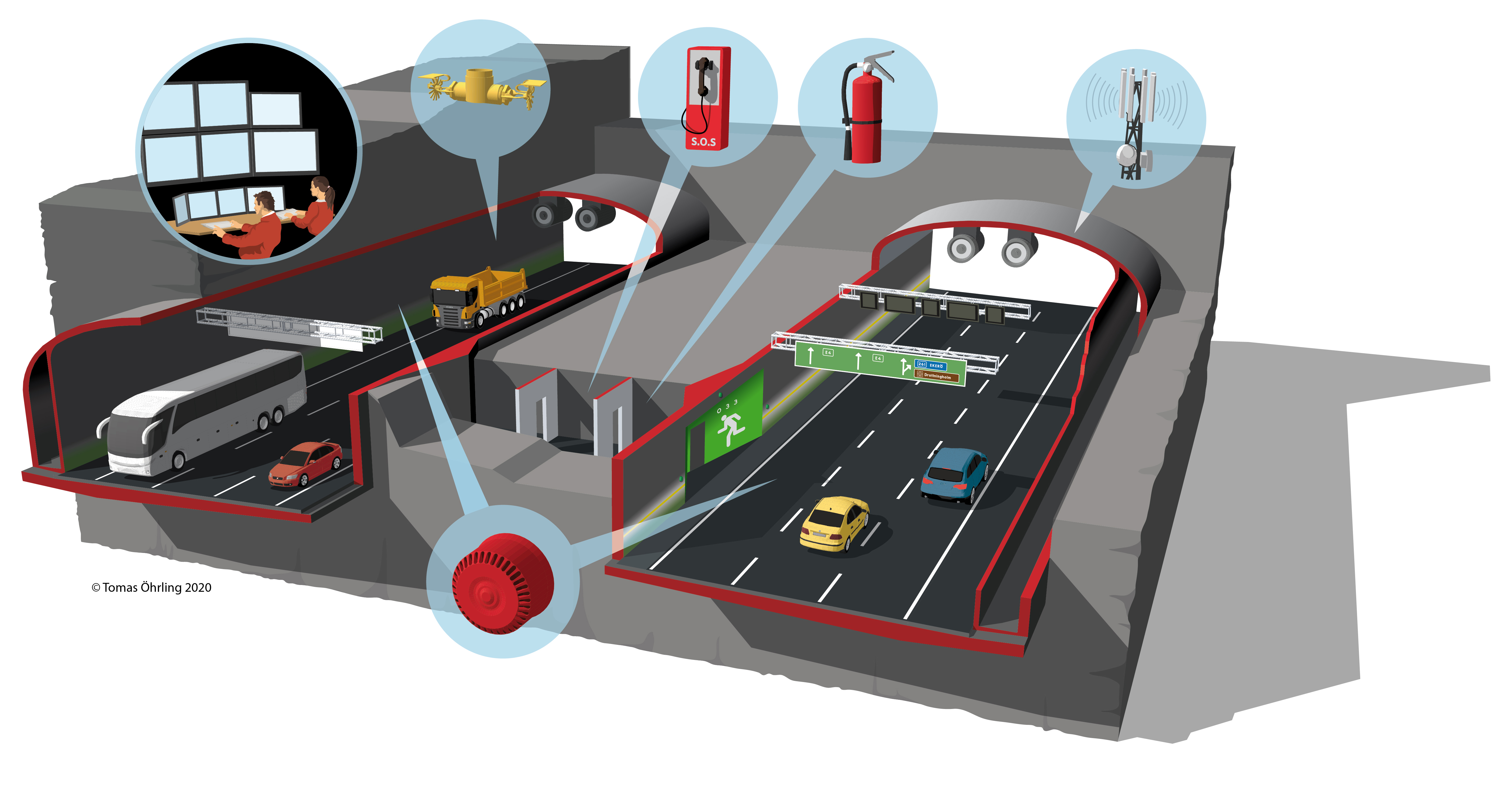
Safety concept - E4 The Stockholm bypass Project
Customer Service Monday to Friday 8 a.m. to 4 p.m.For traffic information and issues that requires immediate attention, we are open all hours.
Tel: +46 (0)771 921 921
A tunnel of this magnitude faces various challenges such as risk for congested traffic, driver fatigue due to monotony, complex fire fighting operations and a need of quick detection of incidents and fires.
The tunnels are designed with the aim of creating a safe journey, with parallel tunnel tubes without oncoming traffic. Ramp tunnels are connecting the main tunnel to the surface road network, and these are also designed as parallel tubes without oncoming traffic.

Self-evacuation - the basis of the tunnel safety concept
The basis of the tunnel safety concept is self-evacuation. Congestion should normally be avoided, with the exception of accidents and incidents, which requires an active traffic management to regulate the traffic flow.
Traffic downstream of an accident should be given possibilities to drive out from the tunnel system and away from a potential danger, whereas road users upstream of the accident can utilise escape routes to walk to the parallel tunnel tube. The escape routes, also referred to as exits, are located every 100 m in the main tunnels, and every 150 m in the ramp tunnels. The escape routes are designed as fire locks to prevent fire and smoke spreading from one tunnel tube to the other.
The tunnel system - monitored and controlled with 24 h CCTV
The tunnel system is to be monitored and controlled by a traffic control centre called Trafik Stockholm. To cater for this, the tunnels are fitted with 24 h CCTV, and various detection systems such as an automatic fire detection system, systems to monitor air quality and a system to detect incidents and stopped vehicles. Doors into the escape routes, emergency telephones and hand-held fire extinguishers are also monitored, which means that for example an opened door will render a signal in the traffic control centre.
The traffic control centre has action plans for all accident scenarios, e.g. vehicle fires, traffic accidents and accidental release of dangerous goods. Recovery plans are also an important part of this concept, with the purpose of restoring traffic in the tunnel as soon as possible after an accident has been dealt with by the tunnel operator and the emergency services. The tunnel system will also be served by a road assistance crew, which among other things can handle minor accidents and prevent stopped vehicles from blocking the traffic flow. Based on experiences from Södra länken and Norrortsleden, the road assistance crew usually arrives to the accident scene at a very early stage, and is of a great help in assisting evacuation if needed.
Communication channels to give road users evacuation messages include variable message signs and emergency radio broadcasts. There will also be mobile phone coverage throughout the tunnel system.
The ventilation concept - based on longitudinal ventilation
The ventilation concept is based on longitudinal ventilation, both for the environmental and fire ventilation, partly achieved by jet fans mounted in the tunnel ceiling. Specific action plans, to be used by the traffic control centre, are developed for the operation of the ventilation system during fires and accidents, including consideration of the aspect congested traffic conditions.
Three air exchange stations, and a specific smoke exhaust tower, divide the tunnel into ventilation sections with a maximum length of approximately 5 km. At the air exchange stations, air from the tunnel system is exhausted and fresh air is taken in from the surface. In addition to this, exhaust towers are located nearby some of the tunnel exits. Air exchange stations and exhaust towers, as well as the specific smoke exhaust tower, can be used for smoke management.
High capacity water drainage system
A water drainage system will be installed throughout the tunnel system, with the capacity of handling an accidental release of liquid dangerous goods, such as petrol. The aim is that there should be no restrictions on the type of transports allowed in the tunnel system.
Traffic management measures
Traffic management measures include, among others, controlled traffic lane signals, ramp metering and boom gates at strategic locations. In case of a fire, all tunnel tubes are closed for incoming traffic.
Fire fighter’s access
Fire fighter’s access is via the escape routes, which are equipped with fire hydrant outlets. A special fire fighters’ radio system, which can also be used by for example the police and ambulance staff, will be installed in the tunnel system.
Fixed fire fighting system
A fixed fire fighting system will be installed throughout the tunnel system. The primary purpose of the system is to slow down the fire growth and assist evacuation.